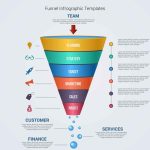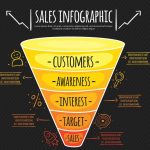Leads are the most important thing for any business because they help it grow and get people to buy things. But how can you get those leads to become paying customers? A well-run lead funnel is where it all begins. A lead funnel is more than just a strategy to get a sale; it’s also a way to show people who are interested in your brand how to go from viewing it for the first time to buying something. We’ll speak about how to take care of your leads, how to build your lead funnel at every stage, and how to encourage more people to buy.
Learning about the Lead Funnel
In order to get more customers, a business has to grasp how the lead funnel works. It shows what a possible consumer does from the first time they talk to your business until they decide to buy anything. Each part of the funnel has a different job to do when it comes to qualifying and nurturing leads. Awareness, Interest, Consideration, Intent, Decision, and Action are the six steps. If you want to turn leads into customers, you need to know how to use each step of the funnel to its fullest. A well-organized lead funnel helps you keep track of leads, learn more about your consumers, and make more sales.
Step 1: Awareness—Getting Leads to Pay Attention
The first step to getting leads is to tell people about your business and get them interested in learning more. People that are interested in your business will find out about it for the first time now, usually through social media, search engines, or content marketing. You need to employ good SEO to get people who are actively looking for answers about your product or service to notice your brand. Blogs, videos, and infographics are all great ways to tell individuals who might be interested in your product more about their problems and how your solution could help. You should also talk to people on social media since it lets you talk to potential clients directly and makes them trust your business.
Step 2: Interest—Taking Care of Possible Leads
The next stage is to keep your leads interested once you have their attention. You should now know more about your leads and be able to keep them interested in what you have to offer. Giving away free eBooks, manuals, webinars, or other lead magnets is a great way to get people’s contact information and give them something useful. This lets you reach out to leads again and provide them further information. Sending each lead information that keeps them interested is a wonderful method to make your email marketing more personal. Now is the time to prove that your brand is valuable and can be trusted.
Step 3: Thinking About It—Showing What You Can Do
Leads are now looking at a variety of other choices and picking the one that works best for them. Now you have to tell them why your product or service is better than the rest. You can show how well your product works by giving demos, writing case studies, and receiving feedback from consumers. You can provide them free samples or entertaining things to do to demonstrate them how your product can help them. If you are honest and open about prices and features, people will trust you more. You need to tell leads how great your offer is right now so they can make a choice.
Stage 4: Intent—Finding Buyers Who Are Serious
Leads are at the intent stage when they want to buy but still have questions. They might wish to look at costs or read reviews before making a choice. Right now, your job is to get rid of anything that would make customers not want to buy. You can entice people to buy by sending them messages that are only for them and giving them deals or discounts that only a few individuals can use. Talking to someone one-on-one, whether over the phone or by email, is a terrific way to relax and create trust. This level is all on getting people to do things and make decisions.
Step 5: Choosing to sell
When leads reach the decision stage, they are ready to buy. They’ve thought over their options and are now ready to pick the one that works best for them. The most important thing is to make it easy for customers to buy. Your website should be easy to use, and your calls to action (CTAs) should be clear and interesting. If you are honest about your rates and don’t charge more, people will trust you more. You can contact or meet with someone in person to help you clinch the deal and answer any last-minute questions you may have. It’s incredibly important right now to make it as easy as possible for leads to become clients.
Stage 6: Action—Closing the Deal
The last step in the lead funnel is when the lead does something, like buy something, sign up for a service, or subscribe to a product. You would think this is the end of the funnel, but it’s really vital to keep taking care of the customer after they buy. Sending clients thank-you emails after they buy anything and explaining them how to get started can make the whole thing go more smoothly. You may get clients to come back and conduct business with you again by offering them loyalty programs or paying them to bring in new customers. Customers are happy and loyal when you stay in touch with them after a sale. This could lead to more business in the future.
How to Get the Most Out of Your Lead Funnel
To help your leads buy, you need to know what they need and give them the right information and answers at every level of the lead funnel. Here are some tips for making the most of your funnel:
- Make Your Leads Stand Out: Every lead is different. Grouping your leads by age, interests, or behavior could make it easier to focus your marketing.
- Lead scoring helps you locate the leads that are most likely to buy from you and allows you focus on them.
- Automate Repetitive Tasks: Marketing automation technologies can help you save time and make sure that leads are always being taken care of at every stage of the funnel.
- To see how well your funnel is performing, look at the conversion rates, lead-to-customer ratios, and click-through rates. Then, change things based on what you learnt.
- A/B testing is when you try out different messages, strategies, and content to see which ones get the most people to do what you want them to do.
You can make it more likely that leads will become loyal clients by making sure that every part of your lead funnel is as good as it can be and by always looking for ways to make your processes better. Good lead management makes sure that every lead gets the aid and attention it needs to move through the funnel without any difficulties. Over time, this will help your firm develop and make more money.
Conclusion
Improving your lead funnel is an important aspect of making sales and keeping your business operating over time. By carefully managing each step of the funnel, from getting people to know about your offer to closing the sale, you can improve the process and get leads closer to making a purchase. You still need to talk to leads even after they buy anything. You need to always talk to and take care of your consumers if you want them to come back. You can improve your lead funnel and get the best results by following our advice, which includes organizing your leads, employing automation tools, and always trying new things. Your firm will expand more slowly and make more money if you pay attention to what your leads need and give them the correct tools at each level.














